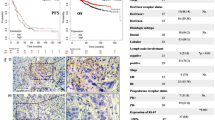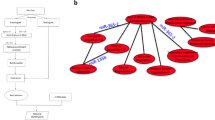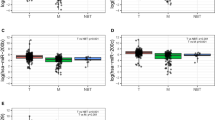Abstract
Understanding the consequences of miR-145 reintroduction in human breast cancer (BC) could reveal its tumor-suppressive functions and may disclose new aspects of BC biology. Therefore, we characterized the effects of miR-145 re-expression in BC cell lines by using proliferation and apoptosis assays. As a result, we found that miR-145 exhibited a pro-apoptotic effect, which is dependent on TP53 activation, and that TP53 activation can, in turn, stimulate miR-145 expression, thus establishing a death-promoting loop between miR-145 and TP53. We also found that miR-145 can downregulate estrogen receptor-α (ER-α) protein expression through direct interaction with two complementary sites within its coding sequence. In conclusion, we described a tumor suppression function of miR-145 in BC cell lines, and we linked miR-145 to TP53 and ER-α. Moreover, our findings support a view that miR-145 re-expression therapy could be mainly envisioned in the specific group of patients with ER-α-positive and/or TP53 wild-type tumors.
Similar content being viewed by others
Log in or create a free account to read this content
Gain free access to this article, as well as selected content from this journal and more on nature.com
or
Accession codes
Abbreviations
- miRNA:
-
microRNA
- mRNA:
-
messenger RNA
- 3′UTR:
-
3′ untranslated region
- BC:
-
breast cancer
- ER-α:
-
estrogen receptor-α
- PCR:
-
polymerase chain reaction
- wt:
-
wild-type
- PI:
-
propidium iodide
- PARP:
-
poly(ADP-ribose) polymerase
- PUMA:
-
p53 upregulated modulator of apoptosis
- CDKN1A:
-
cyclin-dependent kinase inhibitor 1A
- siRNA:
-
small interfering RNA
- ESR1:
-
estrogen receptor 1
- CDS:
-
coding sequence
References
Jemal A, Ward E, Thun MJ . Recent trends in breast cancer incidence rates by age and tumor characteristics among US women. Breast Cancer Res 2007; 9: R28.
Lee Y, Jeon K, Lee JT, Kim S, Kim VN . MicroRNA maturation: stepwise processing and subcellular localization. EMBO J 2002; 21: 4663–4670.
Lim LP, Lau NC, Garrett-Engele P, Grimson A, Schelter JM, Castle J et al. Microarray analysis shows that some microRNAs downregulate large numbers of target mRNAs. Nature 2005; 433: 769–773.
Stefani G, Slack FJ . Small non-coding RNAs in animal development. Nat Rev Mol Cell Biol 2008; 9: 219–230.
Voorhoeve PM, Agami R . Classifying microRNAs in cancer: the good, the bad and the ugly. Biochim Biophys Acta 2007; 1775: 274–282.
Volinia S, Calin GA, Liu CG, Ambs S, Cimmino A, Petrocca F et al. A microRNA expression signature of human solid tumors defines cancer gene targets. Proc Natl Acad Sci USA 2006; 103: 2257–2261.
Lu J, Getz G, Miska EA, Alvarez-Saavedra E, Lamb J, Peck D et al. MicroRNA expression profiles classify human cancers. Nature 2005; 435: 834–838.
Iorio MV, Ferracin M, Liu CG, Veronese A, Spizzo R, Sabbioni S et al. MicroRNA gene expression deregulation in human breast cancer. Cancer Res 2005; 65: 7065–7070.
Michael MZ, O’Connor SM, van Holst Pellekaan NG, Young GP, James RJ . Reduced accumulation of specific microRNAs in colorectal neoplasia. Mol Cancer Res 2003; 1: 882–891.
Yanaihara N, Caplen N, Bowman E, Seike M, Kumamoto K, Yi M et al. Unique microRNA molecular profiles in lung cancer diagnosis and prognosis. Cancer cell 2006; 9: 189–198.
Foekens JA, Sieuwerts AM, Smid M, Look MP, de Weerd V, Boersma AW et al. Four miRNAs associated with aggressiveness of lymph node-negative, estrogen receptor-positive human breast cancer. Proc Natl Acad Sci USA 2008; 105: 13021–13026.
Wang X, Tang S, Le SY, Lu R, Rader JS, Meyers C et al. Aberrant expression of oncogenic and tumor-suppressive microRNAs in cervical cancer is required for cancer cell growth. PLoS ONE 2008; 3: e2557.
Akao Y, Nakagawa Y, Naoe T . MicroRNAs 143 and 145 are possible common onco-microRNAs in human cancers. Oncol Rep 2006; 16: 845–850.
Shi B, Sepp-Lorenzino L, Prisco M, Linsley P, deAngelis T, Baserga R . Micro RNA 145 targets the insulin receptor substrate-1 and inhibits the growth of colon cancer cells. JBiol Chem 2007; 282: 32582–32590.
Shen WF, Hu YL, Uttarwar L, Passegue E, Largman C . MicroRNA-126 regulates HOXA9 by binding to the homeobox. MolCell Biol 2008; 28: 4609–4619.
Xu N, Papagiannakopoulos T, Pan G, Thomson JA, Kosik KS . MicroRNA-145 regulates OCT4, SOX2, and KLF4 and represses pluripotency in human embryonic stem cells. Cell 2009; 137: 647–658.
Nakano K, Vousden KH . PUMA, a novel proapoptotic gene, is induced by p53. Mol Cell 2001; 7: 683–694.
Li Y, Jenkins CW, Nichols MA, Xiong Y . Cell cycle expression and p53 regulation of the cyclin-dependent kinase inhibitor p21. Oncogene 1994; 9: 2261–2268.
Sachdeva M, Zhu S, Wu F, Wu H, Walia V, Kumar S et al. p53 represses c-Myc through induction of the tumor suppressor miR-145. Proc Natl Acad Sci USA 2009; 106: 3207–3212.
He L, He X, Lim LP, de Stanchina E, Xuan Z, Liang Y et al. A microRNA component of the p53 tumour suppressor network. Nature 2007; 447: 1130–1134.
Krek A, Grun D, Poy MN, Wolf R, Rosenberg L, Epstein EJ et al. Combinatorial microRNA target predictions. Nat Genet 2005; 37: 495–500.
John B, Enright AJ, Aravin A, Tuschl T, Sander C, Marks DS . Human microRNA targets. PLoS Biol 2004; 2: e363.
Kiriakidou M, Nelson PT, Kouranov A, Fitziev P, Bouyioukos C, Mourelatos Z et al. A combined computational-experimental approach predicts human microRNA targets. Genes Devel 2004; 18: 1165–1178.
Lewis BP, Burge CB, Bartel DP . Conserved seed pairing, often flanked by adenosines, indicates that thousands of human genes are microRNA targets. Cell 2005; 120: 15–20.
Miranda KC, Huynh T, Tay Y, Ang YS, Tam WL, Thomson AM et al. A pattern-based method for the identification of microRNA binding sites and their corresponding heteroduplexes. Cell 2006; 126: 1203–1217.
Kong YW, Cannell IG, de Moor CH, Hill K, Garside PG, Hamilton TL et al. The mechanism of micro-RNA-mediated translation repression is determined by the promoter of the target gene. Proc Natl Acad Sci USA 2008; 105: 8866–8871.
Grisouard J, Medunjanin S, Hermani A, Shukla A, Mayer D . Glycogen synthase kinase-3 protects estrogen receptor alpha from proteasomal degradation and is required for full transcriptional activity of the receptor. Mol Endocrinol 2007; 21: 2427–2439.
Jordan VC, O’Malley BW . Selective estrogen-receptor modulators and antihormonal resistance in breast cancer. J Clin Oncol 2007; 25: 5815–5824.
Malkin D, Li FP, Strong LC, Fraumeni Jr JF, Nelson CE, Kim DH et al. Germ line p53 mutations in a familial syndrome of breast cancer, sarcomas, and other neoplasms. Science 1990; 250: 1233–1238.
Tsang J, Zhu J, van Oudenaarden A . MicroRNA-mediated feedback and feedforward loops are recurrent network motifs in mammals. Mol Cell 2007; 26: 753–767.
Sylvestre Y, De Guire V, Querido E, Mukhopadhyay UK, Bourdeau V, Major F et al. An E2F/miR-20a autoregulatory feedback loop. J Biol Chem 2007; 282: 2135–2143.
He L, He X, Lowe SW, Hannon GJ . microRNAs join the p53 network – another piece in the tumour-suppression puzzle. Nat Rev 2007; 7: 819–822.
Yamakuchi M, Ferlito M, Lowenstein CJ . miR-34a repression of SIRT1 regulates apoptosis. Proc Natl Acad Sci USA 2008; 105: 13421–13426.
Mattie MD, Benz CC, Bowers J, Sensinger K, Wong L, Scott GK et al. Optimized high-throughput microRNA expression profiling provides novel biomarker assessment of clinical prostate and breast cancer biopsies. Mol Cancer 2006; 5: 24.
Adams BD, Furneaux H, White BA . The micro-ribonucleic acid (miRNA) miR-206 targets the human estrogen receptor-alpha (ERalpha) and represses ERalpha messenger RNA and protein expression in breast cancer cell lines. Mol Endocrinol 2007; 21: 1132–1147.
Zhao JJ, Lin J, Yang H, Kong W, He L, Ma X et al. MicroRNA-221/222 negatively regulates estrogen receptor alpha and is associated with tamoxifen resistance in breast cancer. J Biol Chem 2008; 283: 31079–31086.
Kondo N, Toyama T, Sugiura H, Fujii Y, Yamashita H . miR-206 Expression is down-regulated in estrogen receptor alpha-positive human breast cancer. Cancer Res 2008; 68: 5004–5008.
Akao Y, Nakagawa Y, Naoe T . MicroRNA-143 and -145 in colon cancer. DNA Cell Biol 2007; 26: 311–320.
Michael MZ, SM OC, van Holst Pellekaan NG, Young GP, James RJ . Reduced accumulation of specific microRNAs in colorectal neoplasia. Mol Cancer Res 2003; 1: 882–891.
Schmittgen TD, Lee EJ, Jiang J . High-throughput real-time PCR. Methods Mol Biol 2008; 429: 89–98.
Cimmino A, Calin GA, Fabbri M, Iorio MV, Ferracin M, Shimizu M et al. miR-15 and miR-16 induce apoptosis by targeting BCL2. Proc Natl Acad Sci USA 2005; 102: 13944–13949.
Neve RM, Chin K, Fridlyand J, Yeh J, Baehner FL, Fevr T et al. A collection of breast cancer cell lines for the study of functionally distinct cancer subtypes. Cancer Cell 2006; 10: 515–527.
Acknowledgements
We thank Izabela Fokt (MD Anderson Cancer Center) for Adriamycin synthesis, Deepa Sampath (MD Anderson Cancer Center) for PUMA antibody and the Powis laboratory for the use of a luciferase plate reader. We thank Donald Norwood from the MD Anderson Scientific Publication Department for editing the paper. GAC is supported by The University of Texas MD Anderson Cancer Center Research Trust, The University of Texas System Regents Research Scholar Award and the Ladjevardian Regents Research Scholar Fund. This study was funded also by an Institutional Research Grant and the National Institutes of Health Cancer Center Support (Core) Grant (New Faculty Award) to GAC, and by the Associazione Italiana per la Ricerca sul Cancro and Fondazione Cariplo Progetto NOBEL (to MN).
Author information
Authors and Affiliations
Corresponding authors
Additional information
Edited by G Melino
Supplementary Information accompanies the paper on Cell Death and Differentiation website (http://www.nature.com/cdd)
Supplementary information
Rights and permissions
About this article
Cite this article
Spizzo, R., Nicoloso, M., Lupini, L. et al. miR-145 participates with TP53 in a death-promoting regulatory loop and targets estrogen receptor-α in human breast cancer cells. Cell Death Differ 17, 246–254 (2010). https://doi.org/10.1038/cdd.2009.117
Received:
Revised:
Accepted:
Published:
Issue date:
DOI: https://doi.org/10.1038/cdd.2009.117
Keywords
This article is cited by
-
Regulation of ERα-dependent breast cancer metastasis by a miR-29a signaling
Journal of Experimental & Clinical Cancer Research (2023)
-
The profiles of miR-4510 expression level in breast cancer
Scientific Reports (2023)
-
Expression of miR-145 and miR-18b in Peripheral Blood Samples of Head and Neck Cancer Patients
Indian Journal of Clinical Biochemistry (2023)
-
Identification of miRNA signatures and their therapeutic potentials in prostate cancer
Molecular Biology Reports (2021)
-
Inflammation related miRNAs as an important player between obesity and cancers
Journal of Diabetes & Metabolic Disorders (2019)



